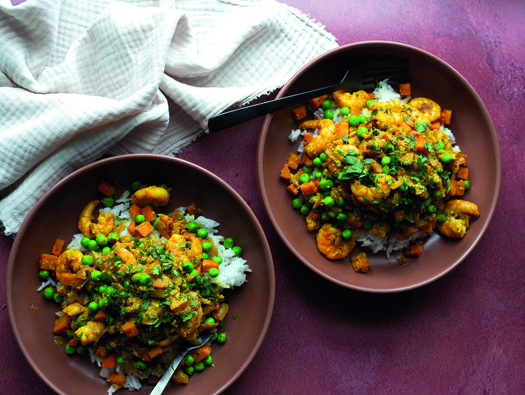South Indian prawn curry

A wonderful use of spices makes this dish a flavourful meal that’s low in salt, potassium and phosphate.

A wonderful use of spices makes this dish a flavourful meal that’s low in salt, potassium and phosphate.
2 tablespoons plain yoghurt
4 cashew nuts or 30g ground almonds
10ml (2 teaspoons) vegetable oil
1 onion, finely diced
1 fresh tomato, cubed
1 teaspoon tomato purée
2cm piece of ginger, grated or finely diced
2 cloves garlic, crushed or finely diced
200g carrots, peeled and chopped
1 whole clove
2 bay leaves
½ cinnamon stick
1 teaspoon cumin powder
2 teaspoons coriander powder
¼ teaspoon chilli powder (adjust for your spice preference)
1 teaspoon turmeric powder
1 teaspoon cracked black pepper
120g long grain or basmati rice
200g raw ready-to-cook prawns
100g frozen peas
2 tablespoons fresh coriander, chopped
Using a pestle and mortar (or the end of a rolling pin and a bowl), crush the cashew nuts into the yoghurt to make a paste. If using ground almonds instead of cashews, simply mix with the yoghurt. Set aside.
Heat the oil in a frying pan over a high heat and add the onion, fresh tomato, tomato purée, ginger and garlic. Mix together well. Add the chopped carrot and cook for ten minutes until the vegetables soften.
Add the clove, bay leaves, cinnamon stick, all the spice powders and the black pepper to the pan. Add a little water (20-40ml) if the ingredients are starting to stick. Allow to cook on a medium heat for another ten minutes.
Rinse the rice with cold water, drain and add to a saucepan of boiling water. Bring to the boil, cover and cook for 12 mins on a medium heat. Add 100ml of water and the prawns to the frying pan. Simmer for 5-10 mins until the prawns are cooked.
Reduce the heat of the frying pan and add the previously made cashew paste and the peas. Cook for another five minutes. This is your prawn curry.
Remove the cinnamon stick, bay leaves and clove from the gravy. Serve the rice on two plates and top with the prawn gravy. Sprinkle over the fresh coriander to serve.
The rice is the main source of carbohydrate and the value has been provided for those who have been trained in insulin adjustment.
This dish is low in potassium. If you have been advised to reduce your potassium, keep to the quantities and serving sizes stated.
This dish is low in phosphate but because it contains prawns (a high phosphate ingredient), follow the quantities and serving sizes stated. If you have been prescribed a phosphate binder, take it with this meal.
This meal is high in protein so is suitable for those receiving dialysis. If you need to eat less protein, use a 400g drained tin of chickpeas or lentils instead of the prawns, or halve the quantity of prawns (100g) and add a 200g drained tin of chickpeas or lentils.
Replace the prawns with a 400g tin of drained lentils or chickpeas or use 200-300g of tofu.
Replace the prawns with a 400g tin of drained lentils or chickpeas or use 200-300g of tofu. Use a plant-based yoghurt.
Use brown wholegrain rice to increase the fibre.
Frozen prawns are often cheaper. You could also omit the fresh coriander and use curry powder instead of cumin and coriander powder.
Once cooked, cool and freeze for up to 3 months. Defrost thoroughly in the fridge before reheating.
If you can’t get raw prawns, you can use cooked prawns and add at step 5 with the peas. This dish can be served with naan bread instead of rice.
Find out more about the hidden salt in your food and what you need to know about carbohydrates in South Asian recipes.
You can enjoy a wide variety of delicious and healthy food when you are living with kidney disease. All Kidney Kitchen recipes are analysed and approved by kidney dietitians. Search through our kidney-friendly recipes or filter them by category below.
A hearty vegan curry which is low in potassium, salt and phosphate and quick and easy to prepare. Perfect for a mid-week dinner!
By giving us your email address, you're giving us permission to send you the latest news from Kidney Care UK. Further information about how we protect and use your personal data is available in our Privacy policy. If you would like to change the way we communicate with you at any time please email [email protected]. You can unsubscribe at any time by using the link at the bottom of every email we send.